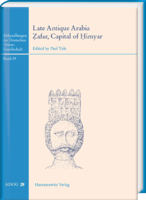|
weitere Titel zum Thema:
The first unification of Arabia emanated from the capital of the Himyarite tribal confederacy, Zafar. Paradoxically, as early as the Islamic Caliphate this site and its civilisation were characterised as ‚decadent‘ representatives of a dark age. New results correct a distorted image. The book by Paul Yule contextualises the data accumulated prior to the untimely termination of the field project as a result of civil strife.
In the field of South Arabian Studies, excavation reports are rare and non-existent for the late pre-Islamic period – which this one accents. By no means alone, Zafar is and needs to be understood in relation to other sites in Arabia. The circumstances surrounding the downfall of the Himyar and post-Himyarite history are fraught with difficulty which this interdisciplinary report strives to illuminate. The often impressionist nature of the archaeological literature is countered by database documentation for the excavation operations and contexts. New are discussions of archaeological finds as well as those regarding art history, religion and linguistics. Detailed data including inscriptions as well as zoological and botanical data illuminate the situation. The author had the rare advantage of working in an area which amounted to an informational vacuum, but which was a centre for the development of early Judaism, Christianity and Islam. The latter was by no means the enemy of Himyar, but rather perhaps its closest descendant. Backed up by the internet image base HeidICON which contains over 4500 drawings and photos, not to omit preliminary reports, lectures as well as a travelling exhibition which provide discussion platforms, the book seeks to remedy this vacuum. |




